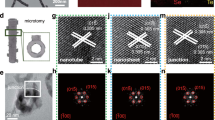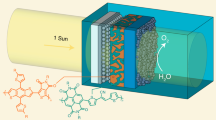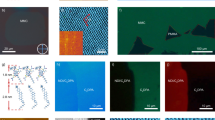Abstract
Semiconductor p–n junctions provide rectification behaviour and act as building blocks in many electronic devices. However, the typical junction configuration restricts the potential functionalities of devices. Here we report a light-detection electrochemical cell that is based on vertically aligned p-AlGaN/n-GaN p–n heterojunction nanowires in an electrolyte environment. After decorating the nanowires with platinum nanoparticles, the cell exhibits a photoresponse in which the photocurrent polarity is reversed depending on the wavelength of light. In particular, illumination of the device at two different wavelengths (254 nm and 365 nm) triggers different redox reactions at the nanowire/electrolyte interface, inducing polarity reversal of the photocurrent. The device offers a responsivity of up to −175 mA W−1 at 254 nm and 31 mA W−1 at 365 nm, both at 0 V.
This is a preview of subscription content, access via your institution
Access options
Access Nature and 54 other Nature Portfolio journals
Get Nature+, our best-value online-access subscription
$29.99 / 30 days
cancel any time
Subscribe to this journal
Receive 12 digital issues and online access to articles
$119.00 per year
only $9.92 per issue
Buy this article
- Purchase on Springer Link
- Instant access to full article PDF
Prices may be subject to local taxes which are calculated during checkout




Similar content being viewed by others
Data availability
The data that support the plots within this paper and other findings of this study are available from the corresponding author upon reasonable request.
References
Zhang, Y. J. et al. Enhanced intrinsic photovoltaic effect in tungsten disulfide nanotubes. Nature 570, 349–353 (2019).
Taniyasu, Y., Kasu, M. & Makimoto, T. An aluminium nitride light-emitting diode with a wavelength of 210 nanometres. Nature 441, 325–328 (2006).
Choi, T., Lee, S., Choi, Y. J., Kiryukhin, V. & Cheong, S. W. Switchable ferroelectric diode and photovoltaic effect in BiFeO3. Science 324, 63–66 (2009).
Bardeen, J. & Brattain, W. H. The transistor, a semi-conductor triode. Phys. Rev. 74, 230 (1948).
Xiao, K. et al. All-perovskite tandem solar cells with 24.2% certified efficiency and area over 1 cm2 using surface-anchoring zwitterionic antioxidant. Nat. Energy 5, 870–880 (2020).
Lin, R. X. et al. Monolithic all-perovskite tandem solar cells with 24.8% efficiency exploiting comproportionation to suppress Sn(II) oxidation in precursor ink. Nat. Energy 4, 864–873 (2019).
Guo, F. et al. A generic concept to overcome bandgap limitations for designing highly efficient multi-junction photovoltaic cells. Nat. Commun. 6, 7730 (2015).
Essig, S. et al. Raising the one-sun conversion efficiency of III–V/Si solar cells to 32.8% for two junctions and 35.9% for three junctions. Nat. Energy 2, 17144 (2017).
Oh, N. et al. Double-heterojunction nanorod light-responsive LEDs for display applications. Science 355, 616–619 (2017).
Chen, Y. et al. Strain engineering and epitaxial stabilization of halide perovskites. Nature 577, 209–215 (2020).
Gu, L. et al. A biomimetic eye with a hemispherical perovskite nanowire array retina. Nature 581, 278–282 (2020).
García de Arquer, F. P., Armin, A., Meredith, P. & Sargent, E. H. Solution-processed semiconductors for next-generation photodetectors. Nat. Rev. Mater. 2, 16100 (2017).
Ouyang, B., Zhang, K. & Yang, Y. Photocurrent polarity controlled by light wavelength in self-powered ZnO nanowires/SnS photodetector system. iScience 1, 16–23 (2018).
Ouyang, B., Zhao, H., Wang, Z. L. & Yang, Y. Dual-polarity response in self-powered ZnO NWs/Sb2Se3 film heterojunction photodetector array for optical communication. Nano Energy 68, 104312 (2020).
Ouyang, B., Wang, Y. H., Zhang, R. Y., Olin, H. & Yang, Y. Dual-polarity output response-based photoelectric devices. Cell Rep. Phys. Sci. 2, 100418 (2021).
Wang, Y. J. et al. An In0.42Ga0.58N tunnel junction nanowire photocathode monolithically integrated on a nonplanar Si wafer. Nano Energy 57, 405–413 (2019).
Fan, S. et al. High efficiency solar-to-hydrogen conversion on a monolithically integrated InGaN/GaN/Si adaptive tunnel junction photocathode. Nano Lett. 15, 2721–2726 (2015).
Kibria, M. G. et al. Visible light-driven efficient overall water splitting using p-type metal-nitride nanowire arrays. Nat. Commun. 6, 6797 (2015).
Seh, Z. W. et al. Combining theory and experiment in electrocatalysis: insights into materials design. Science 355, 6321 (2017).
Chen, S. S., Takata, T. & Domen, K. Particulate photocatalysts for overall water splitting. Nat. Rev. Mater. 2, 17050 (2017).
He, Y. M. et al. Dependence of interface energetics and kinetics on catalyst loading in a photoelectrochemical system. Nano Res. 12, 2378–2384 (2019).
Zhou, B. et al. Gallium nitride nanowire as a linker of molybdenum sulfides and silicon for photoelectrocatalytic water splitting. Nat. Commun. 9, 3856 (2018).
Wenderich, K. & Mul, G. Methods, mechanism, and applications of photodeposition in photocatalysis: a review. Chem. Rev. 116, 14587–14619 (2016).
Li, Z. et al. Surface-polarity-induced spatial charge separation boosts photocatalytic overall water splitting on GaN nanorod arrays. Angew. Chem. Int. Ed. 132, 945–952 (2020).
Takata, T. et al. Photocatalytic water splitting with a quantum efficiency of almost unity. Nature 581, 411–414 (2020).
Li, R. et al. Spatial separation of photogenerated electrons and holes among {010} and {110} crystal facets of BiVO4. Nat. Commun. 4, 1432 (2013).
Kibria, M. G. et al. Tuning the surface Fermi level on p-type gallium nitride nanowires for efficient overall water splitting. Nat. Commun. 5, 3825 (2014).
Cao, L. et al. Atomically dispersed iron hydroxide anchored on Pt for preferential oxidation of CO in H2. Nature 565, 631–635 (2019).
Wang, Y. J. et al. A single-junction cathodic approach for stable unassisted solar water splitting. Joule 3, 2444–2456 (2019).
Varadhan, P. et al. Surface passivation of GaN nanowires for enhanced photoelectrochemical water-splitting. Nano Lett. 17, 1520–1528 (2017).
Chowdhury, F. A., Trudeau, M. L., Guo, H. & Mi, Z. A photochemical diode artificial photosynthesis system for unassisted high efficiency overall pure water splitting. Nat. Commun. 9, 1707 (2018).
Cao, Y. et al. Atomic-level insight into optimizing the hydrogen evolution pathway over a Co1-N4 single-site photocatalyst. Angew. Chem. Int. Ed. 56, 12191–12196 (2017).
Liu, W. et al. Single-site active cobalt-based photocatalyst with a long carrier lifetime for spontaneous overall water splitting. Angew. Chem. Int. Ed. 129, 9440–9445 (2017).
Klahr, B., Gimenez, S., Fabregat-Santiago, F., Bisquert, J. & Hamann, T. W. Photoelectrochemical and impedance spectroscopic investigation of water oxidation with ‘Co–Pi’-coated hematite electrodes. J. Am. Chem. Soc. 134, 16693–16700 (2012).
Dotan, H., Sivula, K., Grätzel, M., Rothschild, A. & Warren, S. C. Probing the photoelectrochemical properties of hematite (α-Fe2O3) electrodes using hydrogen peroxide as a hole scavenger. Energy Environ. Sci. 4, 958–964 (2011).
Ma, N., Zhang, K. & Yang, Y. Photovoltaic–pyroelectric coupled effect induced electricity for self-powered photodetector system. Adv. Mater. 29, 1703694 (2017).
Jiang, H. P., Su, Y. J., Zhu, J., Lu, H. M. & Meng, X. K. Piezoelectric and pyroelectric properties of intrinsic GaN nanowires and nanotubes: size and shape effects. Nano Energy 45, 359–367 (2018).
Ra, Y. H. et al. An electrically pumped surface-emitting semiconductor green laser. Sci. Adv. 6, eaav7523 (2020).
Xie, Z. J. et al. Ultrathin 2D nonlayered tellurium nanosheets: facile liquid-phase exfoliation, characterization, and photoresponse with high performance and enhanced stability. Adv. Funct. Mater. 28, 1705833 (2018).
Kresse, G. & Furthmuller, J. Efficiency of ab-initio total energy calculations for metals and semiconductors using a plane-wave basis set. Comput. Mater. Sci. 6, 15–50 (1996).
Kresse, G. & Furthmuller, J. Efficient iterative schemes for ab initio total-energy calculations using a plane-wave basis set. Phys. Rev. B 54, 11169–11186 (1996).
Grimme, S. Semiempirical GGA-type density functional constructed with a long-range dispersion correction. J. Comput. Chem. 27, 1787–1799 (2006).
Bernardini, F. & Fiorentini, V. Nonlinear macroscopic polarization in III-V nitride alloys. Phys. Rev. B 64, 085207 (2001).
Liu, K. K. et al. Wurtzite BAlN and BGaN alloys for heterointerface polarization engineering. Appl. Phys. Lett. 111, 222106 (2017).
Yin, C. R. et al. Alumina-supported sub-nanometer Pt10 clusters: amorphization and role of the support material in a highly active CO oxidation catalyst. J. Mater. Chem. A 5, 4923–4931 (2017).
Imaoka, T. et al. Platinum clusters with precise numbers of atoms for preparative-scale catalysis. Nat. Commun. 8, 688 (2017).
Zhu, Y. A., Chen, D., Zhou, X. G. & Yuan, W. K. DFT studies of dry reforming of methane on Ni catalyst. Catal. Today 148, 260–267 (2009).
Acknowledgements
This work was funded by the National Natural Science Foundation of China (grant nos. 61905236 and 51961145110), the Fundamental Research Funds for the Central Universities (grant no. WK2100230020), USTC Research Funds of the Double First-Class Initiative (grant no. YD3480002002) and USTC National Synchrotron Radiation Laboratory (grant no. KY2100000099), and was partially carried out at the USTC Center for Micro and Nanoscale Research and Fabrication. We thank W. Wu from USTC for the support of DFT calculation.
Author information
Authors and Affiliations
Contributions
H.S. developed the idea and designed the experiments. D.W., X.L., Y.K., Y.W., S.F., H.Y., M.H.M., H.Z. and Z.M. performed the MBE growth and characterizations, XPS measurement and photodetection experiments, as well as collected and analysed the data. D.W., X.L., Y.K. and S.F. performed Pt nanoparticle decoration and material investigation. X.W. and W.H. conducted and discussed the theoretical calculations. D.W. and H.S performed the aberration-corrected STEM characterization. D.W., L.F., S.L and H.S. co-wrote the paper. All the authors discussed the results and commented on the manuscript.
Corresponding author
Ethics declarations
Competing interests
The authors declare no competing interests.
Additional information
Peer review information Nature Electronics thanks Ya Yang and Daoyou Guo for their contribution to the peer review of this work.
Publisher’s note Springer Nature remains neutral with regard to jurisdictional claims in published maps and institutional affiliations.
Supplementary information
Supplementary Information
Supplementary Figs. 1–10, Note and refs. 1–9.
Rights and permissions
About this article
Cite this article
Wang, D., Liu, X., Kang, Y. et al. Bidirectional photocurrent in p–n heterojunction nanowires. Nat Electron 4, 645–652 (2021). https://doi.org/10.1038/s41928-021-00640-7
Received:
Accepted:
Published:
Issue Date:
DOI: https://doi.org/10.1038/s41928-021-00640-7
This article is cited by
-
Vacuum-ultraviolet (λ < 200 nm) photodetector array
PhotoniX (2024)
-
Frequency-selective perovskite photodetector for anti-interference optical communications
Nature Communications (2024)
-
Low-dimensional wide-bandgap semiconductors for UV photodetectors
Nature Reviews Materials (2023)
-
Lattice-mismatch-free construction of III-V/chalcogenide core-shell heterostructure nanowires
Nature Communications (2023)
-
Enhanced gain and detectivity of unipolar barrier solar blind avalanche photodetector via lattice and band engineering
Nature Communications (2023)



